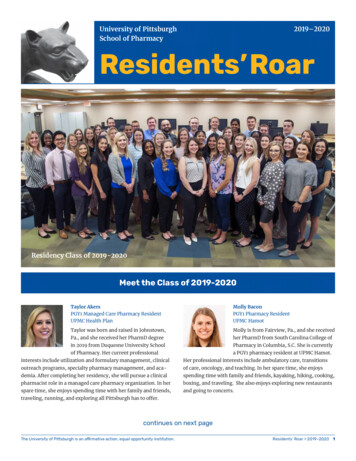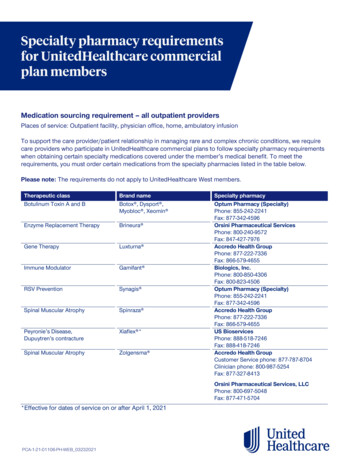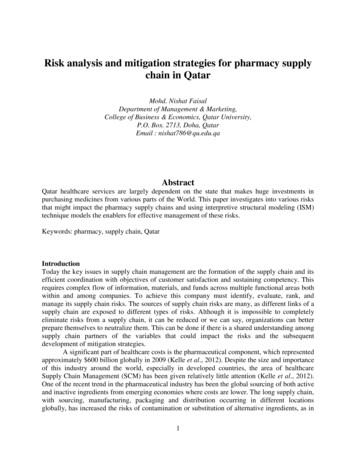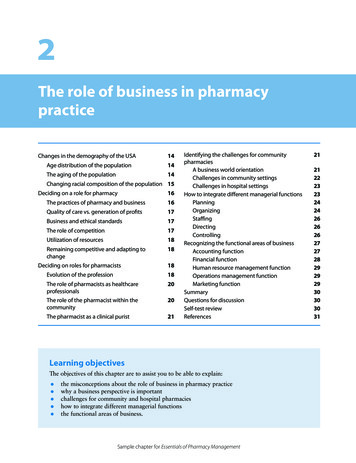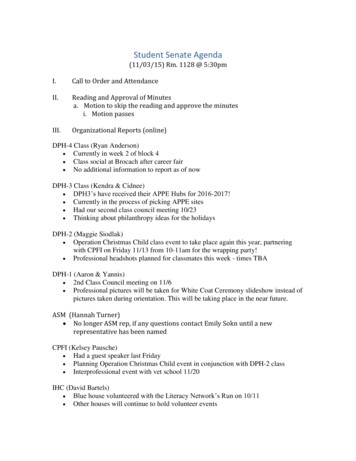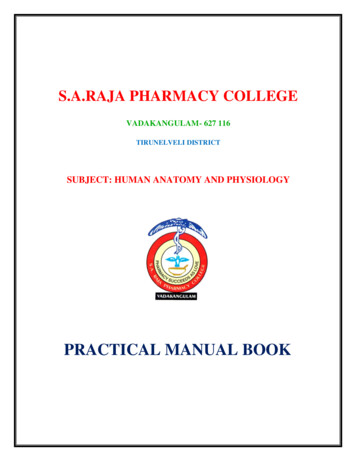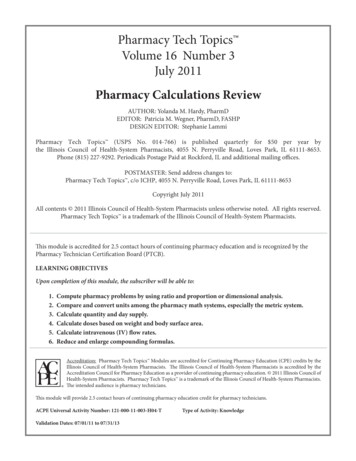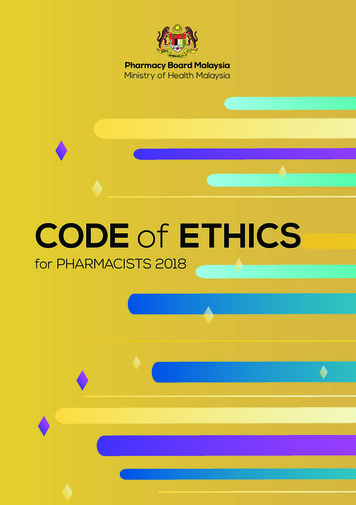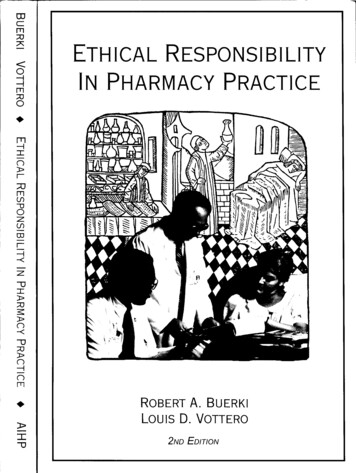
Transcription
EthicalResponsibilityinPharmacyPracticeRobert A. Buerki, Ph.D.ProfessorDivision of Pharmacy Practice and AdministrationThe Ohio State UniversityLouis D. Vottero, M.S.Professor of Pharmacy EmeritusOhio Northern UniversityAmerican Institute of the History of PharmacyMadison, Wisconsin2002
Acknowledgments: Pages 208-10: "Principles of Medical Ethics" and "FundamentalElements of the Patient-Physician Relationship," reprinted with permission from theCode of Medical Ethics, American Medical Association, 1994 and 2000. AMAlogo reprinted with the permission of the American Medical Association. 2002American Medical Association. Usage of the AMA logo does not imply an endorsement of the non-AMA material found in this book.Page 211: "Code of Ethics for Nurses with Interpretive Statements," reprinted withpermission from the American Nurses Association, 2001 American Nurses Publishing, American Nurses Foundation/American Nurses Association, Washington, D.C.Pages 212-15: "A Patient's Bill of Rights," reprinted with permission of the AmericanHospital Association, 1992.Pages 216-17: "Pharmacy Patient's Bill of Rights," reprinted with permission of theNational Association of Boards of Pharmacy.On the cover: The "triad of medical care" has been the basis for theethical relationship between the pharmacist, the physician, and thepatient for centuries. In the background, an early depiction of thetriad from Book 7 of the encyclopedia On the Properties of Things byBartholomew the Englishman, published in Westminster about 1495.In the foreground, a photograph of a contemporary triad (courtesyof the Department of Veterans Affairs).Cover design: Robert A. Buerki and Cynthia A. Gray 1994 and 2002 by Robert A. Buerki and Louis D. VotteroFirst Edition, 1994Reprinted with corrections, 1996Second Edition, 2002ISBN 0-931292-37-9
CONTENTSTABLE OF CASESixINTRODUCTION TO THE SECOND EDITIONxixiiiINTRODUCTION TO THE FIRST EDITIONCHAPTER 1Professional Values in Pharmacy PracticeTraditional professional values in pharmacy practiceShifting professional values in pharmacy practiceIncorporating human values into pharmacy practiceThe Pharmacist as a Health-Care ProviderTraditional boundaries of practiceLegal boundaries of practiceExpanding boundaries of practiceConcluding RemarksStudy QuestionsReferencesSuggested Readings1v2581313141922232428CHAPTER 2Foundations of Ethical Decision-MakingEthical Theories and Principles as a Framework forDecision-Making2930Traditional ethical theories applied to the practice of pharmacy . 32Newer ethical principles applied to the practice of pharmacy33Character and virtue in the practice of pharmacy34Rights and duties in the practice of pharmacy38
viETHICAL RESPONSIBILITYProfessional Codes as a Framework for Decision-MakingDifficulties associated with traditional codesA Framework for Ethical Decision-Making inPharmacy PracticeStep one: Problem identificationStep two: Develop alternative courses of actionStep three: Select one alternative course of actionStep four: Consider objections to alternative selectedApplying the Ethical Decision-Making FrameworkDecisions influenced by professional authorityDecisions influenced by technical competenceDecisions influenced by codes or rulesDecisions influenced by legislationDecisions influenced by personal and professional valuesDecisions influenced by economic forcesConcluding RemarksStudy QuestionsSituations for AnalysisReferencesSuggested TER 3T h e Pharmacist-Patient RelationshipThe nature of the pharmacist-patient relationshipThe complexity of the pharmacist-patient relationshipThe Moral Basis of the Pharmacist-Patient RelationshipMoral principles affecting the relationshipObserving faithfulness in the relationshipIncorporating other patient-centered valuesConflicts among Role ObligationsMaintaining patient faithfulnessRestricting professional servicesObserving truthfulness in placebo therapyReconciling guilt feelingsMaintaining patient confidentialityConcluding RemarksStudy QuestionsSituations for AnalysisReferencesSuggested Readings717274757679818383868891939595959699
CONTENTSviiCHAPTER 4Ethical Considerations in Professional CommunicationsCommunication as an ethical standardCommunication as a practice standardEthical Considerations in Pharmacy CommunicationConsiderations when initiating drug therapyConsiderations when monitoring drug therapyConsiderations involving irrational prescribingConsiderations involving adverse drug reactionsConsiderations involving self-medicationEncounters with Other Health ProfessionalsEstablishing professional communicationsValidating professional decisionsReviewing therapeutic decisionsEncounters with Other PharmacistsDealing with impaired colleaguesMaintaining continuity of patient careReconciling perceived discrepanciesEncounters with the General PublicEstablishing a professional imageChampioning the cause of public healthExtending professional services to the publicConcluding RemarksStudy QuestionsSituations for AnalysisReferencesSuggested 131132134135136137139140141141142147CHAPTER 5Ethical Considerations in Drug DistributionExpansion of the drug distribution systemShifting public perspectives of drug distributionImpact upon Professional Pharmacy PracticeFreedom of choice of drugs and servicesThe fully informed consumer of drugs and servicesAccess to drugs and professional servicesDealing with terminal illnessControlling the prices of prescription medicationWrestling with the challenges of alternative medicinesConcluding Remarks149150151154155160165170174178182
viiiETHICAL RESPONSIBILITYStudy QuestionsSituations for AnalysisReferencesSuggested Readings183183184187APPENDIX ACodes of EthicsHippocratic Oath, 4th century B.CPhiladelphia College of Pharmacy, 1848American Pharmaceutical Association, 1852American Pharmaceutical Association, 1922American Pharmaceutical Association, 1952American Pharmaceutical Association, 1969American Pharmaceutical Association, 1981American Pharmaceutical Association, 1994American Medical Association, 2001American Nurses Association, 2001American Hospital Association, 1992National Association of Boards of Pharmacy, 1992American Pharmaceutical Association Pledge ofProfessionalism, 216218219APPENDIX BFacies Pro Causis223APPENDIX CGlossaryINDEX231249
TABLE OF CASESCase 2.1: Conflicts in TherapyCase 2.2: Conflicts in Drug SelectionCase 2.3: Conflicts in Professional EtiquetteCase 2.4: Conflicts between Legal and Ethical PracticeCase 2.5: Conflicts between Value SystemsCase 2.6: Conflicts Arising From Profit MotivesCase 3.1: Loyalty to Patient CareCase 3.2: Observing Employment PoliciesCase 3.3: Curtailing Counseling ServicesCase 3.4: Managing Conflicting ServicesCase 3.5: Interpreting Placebo TherapyCase 3.6: Identifying Placebo TherapyCase 3.7: Providing Comprehensive Drug InformationCase 3.8: Providing Incomplete Drug InformationCase 3.9: Establishing the Boundaries of ConfidentialityCase 3.10: Restricting Access to Patient InformationCase 4.1: Assuring Informed ConsentCase 4.2: Implementing Drug Utilization ReviewCase 4.3: Establishing Rational TherapyCase 4.4: Monitoring Untoward ReactionsCase 4.5: Assuring Rational AutotherapyCase 4.6: Clarifying Physician OrdersCase 4.7: Questioning Drug SelectionCase 4.8: Monitoring Drug UtilizationCase 4.9: Assessing Professional CompetenceCase 4.10: Preserving Patient ConfidenceCase 4.11: Defending Drug Product SelectionCase 4.12: Advertising Professional ServicesCase 4.13: Monitoring Questionable ProductsCase 4.14: Performing Compassionate ActsCase 5.1: Directing Prescription OrdersCase 5.2: Limiting Access to ServiceCase 5.3: Fractionating Pharmacy ServicesCase 5.4: Advertising Prescription PricesCase 5.5: Choosing among Multisource DrugsCase 5.6: Direct-to-Consumer 62163
xETHICAL RESPONSIBILITYCase 5.7: Exercising Professional Discretion165Case 5.8: Managing Third-Party Program Conflicts167Case 5.9: Participating in Investigational Studies169Case 5.10: Managing Cases of Terminal Sedation171Case 5.11: Managing Cases of Euthanasia173Case 5.12: Professional Responsibility in ControllingPrescription Prices175Case 5.13: Serving the Patient within the Boundariesof the Health-Care System177Case 5.14: Dealing with Requests for Homeopathic Remedies . 179Case 5.15: Balancing Alternative and RationalMedical Practices180
INTRODUCTION TO THE SECOND EDITIONIn the decade since this little textbook was conceived, the American practice of pharmacy has undergone a profound sea change. Inthe early 1990s, pharmacy educators were still debating whetherthe entry-level Pharm.D. should be a universal requirement; Congress briefly considered, then quickly dropped, a plan which wouldhave provided the United States with national health insurance, including a prescription benefit; "pharmaceutically assisted death"became a reality in Oregon; OBRA '90 brought legislative grit tothe ethical mandate for patient counseling by pharmacists; and theAmerican Pharmaceutical Association established a broad-basedcommittee to develop a code of ethics for all pharmacists. Ridingthe crest of these waves was the new practice philosophy of pharmaceutical care, so full of professional promise, yet untested in everyday pharmacy practice.All these changes brought a new interest and urgency to theteaching of professional ethics in our schools and colleges of pharmacy. The AACP's Commission to Implement Change in Pharmaceutical Education included "facility with values and ethical principles" in its statement of general educational outcomes, whichwere given added importance when adopted as accreditation criteria by the American Council on Pharmaceutical Education; thehandful of elective courses that had survived the curricular crunchof the 1990s were dusted off and given new life; our friend and colleague, Amy Haddad, organized a brilliant series of workshops forteachers of pharmacy ethics, including one on the ethics of pharmaceutical care; the American Association of Colleges of Pharmacy supported the creation of an Ethics Special Interest Group(SIG); new textbooks on pharmacy ethics (including this one) appeared on the market; the Code of Ethics for Pharmacists was ratified by members of the American Pharmaceutical Association in1994 and offered to the profession.By the end of the decade, the Doctor of Pharmacy degreewas the standard entry-level preparation for pharmacy practice; asthe baby-boom generation settled into retirement and anecdotage,the demand for prescriptions approached and then exceeded 3 billion orders annually; schools and colleges of pharmacy could notxi
xiiETHICAL RESPONSIBILITYgraduate enough pharmacists to meet the demand, and the institutions themselves reproduced at a rate no one would have predictedten years earlier; pharmacy technicians graduated from certifiedprograms and were licensed in some states, adding a new fillip tothe pharmacy manpower problem; mail-order prescription programs, once dismissed as an annoyance, now set industry standardsfor speed and reliability in a multibillion-dollar prescription market; direct-to-consumer prescription drug advertising soared andInternet "pharmacies" thrived, giving consumers unprecedentedfreedom in the choice of their therapy; advanced computer software and robotics promised to free the pharmacist's time to counselpatients, but the OBRA-mandated "offer to counsel" was still toooften observed in its breach; the notion of pharmaceutical care hasbeen embraced by the profession, but the practice philosophy stillstruggles in its implementation, as deep-discount pharmacy chainscontinue to believe that all the American public wants from itspharmacists is good, cheap prescription drugs delivered up asquickly as possible; and the Code of Ethics for Pharmacists has yetto be universally adopted by the pharmacy profession, as itstruggles once again to redefine its societal purpose.This new edition of Ethical Responsibility in Pharmacy Practice includes new sections on controversial topics such as terminalsedation, euthanasia, and assisted suicide; ethical issues associatedwith controlling prices on prescription medication; and the ethicalchallenges presented by alternative medications. A commentaryhas been added to each case study, which pharmacy studentsshould find useful as they develop their own set of professionalpractice values and methods of resolving the ethical conflicts theywill face in their professional practice; an extensive glossary ofterms also has been added as a courtesy to the reader. Our educational goal, however, stated in 1994, remains the same: "By introducing students to ethical concepts, giving them directed practicein applying ethical principles, and allowing them to develop skillsin problem-solving and critical thinking, the instructor of professional ethics can heighten student sensitivity, increase professionalawareness, and, indirectly, improve health care at the critical pharmacist-patient interface."
INTRODUCTION TO THE FIRST EDITIONAmerica appears to have been foundering in an ethical crisis for thepast several years. As individuals in the highest ranks of government, the clergy, business, and sports became caught in a quagmireof lies, sharp dealing, impropriety, and scandal, Americans beganto reexamine the underlying moral tenets in our society and foundthem wanting. Politicians charged that educators condoned andeven fostered a plurality of values in our school systems; educatorspointed to the decline in church attendance as the root of the problem; and clergy blamed the government for removing moral teachings from public education on overly zealous Constitutionalgrounds. At the same time, the American health-care system underwent its most tortuous redefinition in recent history as thirdparties started to examine quality of care, professional competence,allocation of resources, and to insist upon health maintenance, allwithin the pervading aura of cost-containment. Finally, an increasingly sophisticated public demanded that its health care be notonly more affordable, but virtually flawless in its outcomes. The alternative, it declared, was litigation, and malpractice insurancerates soared.Throughout this turmoil, American pharmacy emerged remarkably unscathed. Its practitioners basked in the warm glow ofpublic trust and confidence and continued to expand patient services. Pharmacy educators began to stress interpersonal communication skills in their already crowded curricula in an attempt to enhance patient care through improved compliance with prescribedmedication. Yet as patient communication increased, the naggingethical issues of preserving patient confidentiality and autonomywhile maintaining openness and truthfulness tested the resourcefulness of pharmacy practitioners and students alike. To be sure,pharmacy ethics has traditionally held a small place in the schemeof pharmaceutical education, if only relegated to a dean intoningthe APhA Code of Ethics to his senior pharmacy students on theeve of their graduation. Yet by the mid-1970s, court decisions hadseriously eroded the role of codes of ethics in maintaining standards of professional practice beyond that required by law and hadbrought into question the role that peer review should play in enxiii
xivETHICAL RESPONSIBILITYsuring a collective self-discipline. Faced with uncertain alternativesand what they perceived to be a crumbling of the nation's moralfoundations, pharmacy educators began looked at formal instruction in professional ethics with new interest and commitment. Atthe same time, leaders in pharmacy practice called for a review ofthe profession's code of ethics, requesting the APhA to spearheadthe development of a new "Code of Ethics for Pharmacists." Ethical Responsibility in Pharmacy Practice is the result of this interestand commitment; it would not have been published five years ago.Instruction in professional ethics in a school or college ofpharmacy poses several unusual challenges: To the student inuredto scientific facts, reproducible laboratory values, and precise measurements, the study of ethics seems maddeningly arbitrary, a graymorass of competing principles that intrude upon a black-andwhite world of unquestioned facts. Moreover, the student must notonly master ethical principles, but learn to choose among alternatives and resolve ethical dilemmas at the higher level of abstractionrepresented by such problem-solving skills. To the instructor whocannot typically claim expertise in moral philosophy at the graduate level and may not be intimately familiar with the ethical dilemmas that plague today's pharmacy practitioners, the teaching ofethics may prove an uncomfortable, even threatening assignment,particularly in the give-and-take arena of small-group discussion.Moreover, the instructor may feel uneasy in taking a personalstand on ethical issues discussed in the classroom setting. Finally,the administrator who feels obliged to include required instructionin ethics in an already overcrowded undergraduate pharmacy curriculum is often caught between the specter of tokenism and theequally unattractive alternative of eliminating or compromisingother course work.The authors have had the luxury of testing out their ideas byteaching professional ethics to small groups of interested pharmacystudents in elective proseminars over the past two decades. Upperdivision pharmacy students who have had at least a modicum ofpractical experience in either the hospital or the community settingseem to profit most from weekly two-hour proseminars. While lectures are useful in conveying basic ethical principles, small-groupdiscussions of no more than twenty-five students are necessary todevelop the skills of critical thinking and problem-solving uponwhich intelligent ethical decision-making is based. Moreover, thestudents learn to become tolerant to a wide range of opinion fromtheir contemporaries, which enhances the learning situation. Although this book has been primarily designed as a text for free-
INTRODUCTIONXVstanding courses in pharmacy ethics, teachers of jurisprudence, dispensing, or clinical practice may wish to use it as a companion textto introduce basic concepts of applied ethical decision-making.Moreover, preceptors in externship and clerkship settings can usethe text to complement their individual mentoring of advancedpharmacy students prior to graduation.The authors strongly believe that trends in professional values and ethical standards can be understood best within the historical context of American pharmacy practice. For example, whileolder versions of professional codes of ethics mirror changes in professional practices over time, reflecting changes in educationalstandards, legal obligations, and professional functions, the newlyadopted Code of Ethics for Pharmacists reflects a fundamentalshift to an ethos based upon morals and virtues. Accordingly, thistext has been designed to reflect the developmental changes in thepractice of pharmacy over the past century and to account for thetransformation in professional values and ethics engendered bythese changes. The ethical issues associated with each topical areaconsidered—pharmacist-patient relationships, professional communications, and drug distribution—have also been developed withintheir own unique historical contexts.While the teaching of professional ethics is undoubtedly labor-intensive, it can also be deeply satisfying: By introducing students to ethical concepts, giving them directed practice in applyingethical principles, and allowing them to develop skills in problemsolving and critical thinking, the instructor of professional ethicscan heighten student sensitivity, increase professional awareness,and, indirectly, improve health care at the critical pharmacist-patient interface. Ethical Responsibility in Pharmacy Practice is ourmodest contribution to these goals.
CHAPTER 1PROFESSIONAL VALUES INPHARMACY PRACTICEThe traditional function of pharmacy practice—compounding anddispensing medications directly to the public in a safe and reliablemanner—predates the emergence of the pharmacy profession itself.In every age and in every culture, individuals have taken the ratherawesome responsibility for learning about and preparing medicinesfor others and, in a sense, managing their health care. The practiceof pharmacy and, indeed, all healing professions is an intensely personal, peculiarly human activity that has been traditionally guidedby such basic human values as compassion, dignity, justice, andtruth. In recent times, the importance of these values has been underscored by surgical virtuosity, the prospect of pharmacogenomicdrugs, and other dazzling technical innovations that have revolutionized modern medical and pharmaceutical practice.Although human values are more commonly associated withsuch humanistic disciplines as philosophy and religion, health professionals are beginning to realize that the success of their medicalinterventions with their patients depends as much upon interpersonal, value-based relationships as it does upon technical competence. When the full range of personal and societal values associated with pharmacy practice is taken into consideration, even theseemingly benign activity of recommending a nonprescriptionmedication takes on added meaning. Rather than making a quickclinical judgment and recommending a product, pharmacists sensitive to their patients' individual needs may defer a "sale," recommend medical intervention, suggest a change in life style, or just offer comfort and reassurance. To what extent, for example, does theperceived socioeconomic status of the patient determine the extentand nature of the professional services pharmacists provide? Towhat extent do the pressures for cost-containment influence thepharmacist's drug-product selection process? How does the accep-
2ETHICAL RESPONSIBILITYtance of the practice philosophy of pharmaceutical care affect thevalue system of American pharmacists? Indeed, human valuesseem to be so completely integrated with modern health-care practices, that one might argue that the so-called "ideal" of a highlytechnical, purely clinical, and "value-free" practice of medicine orpharmacy is neither possible nor even desirable. Thus, any vauntedclaim of "value neutrality" in contemporary health-care practicesmay be no more than a tolerance for a plurality of values or, worse,an excuse to avoid dealing with ethical dilemmas altogether. Wemust, however, remember the uniqueness of individual personalvalue systems: our righteous indignation over colleagues who appear to be avoiding moral responsibility very well may be a reaction to the unsettling possibility that they do not hold our values.Traditional professional values in pharmacy practiceBy the end of the nineteenth century, the practice of pharmacy in the United States emerged as a socially necessary function, distinct from medicine, and sanctioned by society. These sanctions took the form of licensure laws and examination proceduresthat established a benchmark for professional pharmacy practice.Turn-of-the-century pharmacists not only fulfilled their professional function of compounding and dispensing physicians' prescriptions, but also served as self-appointed guardians and advisors, dedicated to protecting their customers from dangerouspoisons or fraudulent patent medicines. In some hospitals andother institutions, a handful of pharmacists manufactured irrigating solutions and prepared other drug products in bulk as their primary activity. In neighborhood drugstores, most pharmacists subsidized their professional function by selling other drug-relateditems and a wide range of so-called "lines"—cosmetics, tobaccos,sodas, sundries, and other unrelated commodities in an essentiallymercantile setting. These pharmacists displayed a genuine concernfor their patrons, dispensing simple drugs, patent medicines, andhomely health-care advice to a trusting, unsophisticated clientele,earning their respect and the sobriquet "Doc." The basic value ofpharmacy practice was built upon personal service, which affirmedpharmacists' belief in themselves as health-care professionals.In burgeoning colleges of pharmacy, avuncular pharmacistprofessors emphasized the identification, assaying, and testing ofdrug products, and the careful weighing, compounding, and dispensing of prescriptions. By the mid-1980s, universally requiredbaccalaureate programs in pharmacy sought to infuse a well-
PROFESSIONAL VALUES IN PHARMACY PRACTICE3rounded general education into the traditional professional curriculum, a strategy calculated to result in both professional and publicrespect. "Your pharmacist is the scientist on the corner," public relations campaigns of the period proudly proclaimed. Licensureboards began to supervise components of practice through internship programs, a remnant of the traditional apprenticeship systemof training. In the corner drugstore, good pharmaceutical servicewas defined in terms of elegantly prepared drug products withneatly-typed labels; hospital pharmacists stocked "drug rooms"from which doctors and nurses could obtain the drugs their patients needed. At about the same time, pharmaceutical manufacturers began to market more effective and sophisticated finisheddosage forms that did not require further compounding by individual practitioners. Many pharmacists, however, resisted thistechnological intrusion and continued to cling to their limited vision of pharmaceutical service, bounded by the traditional compounding and distributive functions. Others even sought to increase this function by promoting so-called U.S.P. and N.F."propaganda" campaigns through their state pharmaceutical associations. These campaigns encouraged physicians to write prescriptions for formulas in the official compendia that pharmacists couldextemporaneously compound instead of merely dispensing thecommercially available versions of the same products.1 Certaingroups of pharmacists continue to resist external challenges totheir comfortable practice environments. As we will see, mail-orderpharmacy operations, prescription insurance programs, and mandated patient counseling spark debates among today's pharmacistsas stirring as the struggle to maintain the compounding function ofsixty years ago.By the early 1940s, drug therapy continued to evolve frompalliative, symptomatic treatments to specific, effective chemotherapeutic agents. The focus of the pharmacist's professional function in all settings began to shift from the extemporaneous compounding of simple drug products to the increasingly efficient,cost-effective dispensing of dosage forms prepared by large, specialized pharmaceutical manufacturers. In teaching hospitals andother institutions, rededicated to therapeutic effectiveness and better patient services, a growing number of committed pharmacistsdefined the first practice specialty in pharmacy, one which began tofocus upon serving individual patient needs through a system ofoptimum drug distribution.2In the community setting, the concepts of self-service andmass merchandising redefined first chain and then independent
ETHICAL RESPONSIBILITYEdward Parrish (1822-72),author of the 1857 essay"Ethical Analysis," possibly thefirst serious consideration ofAmerican pharmacists' moralresponsibilities. {KremersReference Files, F. B. PowerPharmaceutical Library,University of WisconsinMadison.)In 1848 the Philadelphia College of Pharmacy promulgated the firstAmerican code of ethics for pharmacists. The painting "AmericanPharmacy Builds Its Foundations" by Robert Thorn shows the artist'sconception of the founding of the College in 1821. (Illustration courtesyof Parke-Davis, division of Warner Lambert.)
PROFESSIONAL VALUES IN PHARMACY PRACTICE5pharmacy practice, just as they had redefined the grocery and department stores of the 1930s. The steady growth of aggressivedrugstore chains, which often considered their prescription departments as just another "line," frustrated many independent pharmacy practitioners. Some simply attempted to compete head-onwith the chains in disastrous price-cutting wars; other more professionally minded pharmacists tried to promote their prescription departments while still providing the wide range of merchandise andservices that had come to characterize the American drugstore. Despite the sweeping societal changes swirling about them, pharmacists continued to cling to their traditional service value. In theirzeal to "serve the public," pharmacists added new "lines," providedfree delivery for minor purchases, opened family charge accounts,sold postage stamps, and maintained mind-numbing sixteen-hourwork days, seven days a week, providing the high level of servicethey felt the public expected from their corner drugstore.3In this product-centered practice, professional values weredominated by service and accuracy. Pharmacists provided quick,attentive service and accurately prepared drug products for theirpatients, most of whom they usually referred to as "patrons" or"customers." Pharmacists prided themselves on the warm, interpersonal relationships they established with their patients, but refrained from taking any active responsibility for their health care,merely recommending either physician intervention or only themost benign over-the-counter remedies. To do otherwise, that is, toengage in so-called "counter-prescribing," would have encroachedupon the physician's prerogative to diagnose and prescribe and wastherefore considered strictly unethical. These self-imposed limitson professional activity not only restricted the pharmacist's patient-care inter
ment of the non-AMA material found in this book. Page 211: "Code of Ethics for Nurses with Interpretive Statements," reprinted with . Considerations when initiating drug therapy 118 . ware and robotics promised to free the pharmacist's time to counsel patients, b


